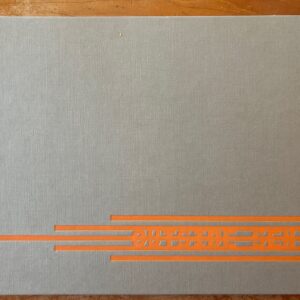JTF (just the facts): Self-published in 2023 (here). Hardcover, 285 x 235 mm, 112 pages, with 55 black-and-white reproductions. Includes a short afterword by the artist and a list of plates. In an edition of 750 copies. Design by Duncan Whyte. (Cover and spread shots below.)
Comments/Context: At this point, the idea that the process of photographic image making is something akin to “drawing with light” is a pretty tired metaphor, and one that seems to implicitly misunderstand and undervalue the possibilities of photographic darkness. Across the history of the medium, plenty of master photographers have championed the richness of black tones – Ray Metzker and Roy DeCarava come quickly to mind, and there are plenty of others who have deliberately turned to the dark side.
As it turns out, embracing the subtleties of deep, enveloping photographic black is decently difficult, and generally requires a meticulous mastery of the printing process to tease the depths of black out of any particular negative. So the fact that Dominic Turner is a master photographic printer in Dublin, Ireland, with experience in a variety of processes, may provide a partial explanation for why the blacks in his self-published photobook False Friends are so nuanced and tactile – he clearly knows what he’s doing in the dark registers, which thereby opens up avenues for creative expression via printing that many other photographers can’t really access as effectively.
Turner has aimed his mastery of photographic textures, grain, and contrast at a selection of images that edge toward uncertainty, where his tuning of the tones and surfaces pushes the pictures into zones of ambiguity, often with darkness (and its opposite) as the prevailing visual theme or symbolic mood. Many of his compositions feature a single figure (or single building, animal, or tree) set into a much larger scene, in a manner that the scale of the surroundings dwarfs or isolates the lone subject, in a few cases to the point that it is difficult to find. He offers us a single boat in the water, a single church with thorny brush in the foreground, a single man lying on a rocky outcrop and another sitting at the beach, a single gull near a stormy sea, a single house in a snowy landscape, and a single tree isolated in a field of snowy whiteness. In each case, the scene is unbalanced, creating a sense of implied tension in even the most placid and simple of views.
Another motif Turner favors is to place light within thick surroundings of darkness, creating a tunneled or spotlit effect that narrows our attention on a chosen subject. A flip through False Friends creates a parade of these apprehensively contrasty moments: white birds on dark branches, street lights along a road at night, amorphous jellyfish in dark water, the embroidered back of a dress in shadow, the moon in the misty night sky, blurred figures dancing, balloons hung on a gate, and even a white wolf seen in the looming darkness with the glowing aesthetics of night vision. These moments have a consistent undercurrent of disquiet, where even jaunty pinprick lights cast a shivery chill down your spine.
Turner’s prowess as a printer really shines in a few images where the blacks become intensely rich and velvety, like deep dark voids. He finds this note of flat surreal emptiness in the side of barn, the face of a man in a white shirt, and in the space that falls away from an overlook point, where it’s as if the image tears open to reveal the hollow echoing blackness underneath. A related effect occurs in a couple of sinuous landscapes, where Turner pushes the tonalities to extremes, encouraging layers of curves to settle into different gradient points.
Given all these oblique moments of darkness, it isn’t perhaps surprising that Turner might want to communicate more directly, if only to warn us in some manner, and he does so with Ed Ruscha-like word fragments that seem to offer cryptic snippets of communication. But the “Important Notice” is of course decayed and unreadable, leaving us either “Success” or “Pain”, with “California” still jaunty with a palm tree but ominously dry cracked. Other messages are even more obtuse, from contrails scratched across the sky like runes or codes to a drink splashed across a bedroom floor like the aftermath of some intense event. With a surveillance camera perched in the trees, it’s no wonder some of Turner’s subjects have donned masks, or use their hands to shield their faces from the light.
As Turner builds this cocktail of dark tension in page turn after page turn, he’s also provided plenty of potential escape routes, in the form of ladders, roads, train tracks, and boardwalks, each seemingly offering a way out of the encroaching darkness. They go up hillsides, come out of the water, curve through meadows, stand against palm trees and stucco walls, and bend through various dark lands and rocky vistas, like portals to other worlds. And one image features an abandoned car with the doors left open, as though the driver crashed into the scrub and just decided to wander off.
For a self-published effort, False Friends has been designed and constructed with an unexpected level of precision and poise. The blue clothbound cover features dark graphic elements that look like branches, with the title and artist’s name placed only on the spine. Inside, blue endpapers match the cover, and the flow of the pages is interrupted by quick color divisions (in orange, grey, brown, and green), which expand a cropped portion of one of Turner’s images to full bleed in the tinted hue. Otherwise, the photographs have been presented on a tactile soft white paper stock, with vertical images placed on one side or the other of the spreads and horizontal images spreading across the gutter, always anchored on the right. The resulting flow is quietly luxurious, with an ample amount of white space to balance the darkness of the images. False Friends is clearly a carefully crafted photobook object, with each decision made deliberately and thoughtfully.
As I’ve spent time with False Friends, it has grown on me; I first thought the simplicity of many of the images was a bit too obvious, but as I paid more attention to Turner’s execution of those printed images (in the manner of Ansel Adams “playing” a photographic negative like a musical score), I became better attuned to the ways the artist has hand tuned the tonalities of each one. This is a photo book filled with shadows and mysteries, not in an overly precious or cloying manner, but in a way that leverages Turner’s strengths into an aesthetic that can be his own. In his afterword, Turner alludes to “the soothing powers of the shade”, but I’m not sure I felt the same comfort in his darkness; instead, I liked the applied ambiguity of each and every scene, where Turner’s control of the darkness is a powerful amplifier (or destabilizer) of mood and atmosphere. To my eye, False Friends is consistently just a bit unnerving, which is exactly what makes it so smart and memorable.
Collector’s POV: Dominic Turner does not appear to have consistent gallery representation at this time. As a result, interested collectors should likely follow up directly with the artist via his website (linked in the sidebar).
























